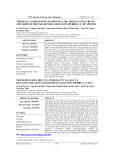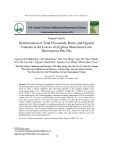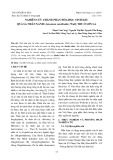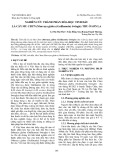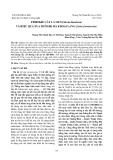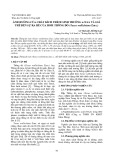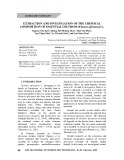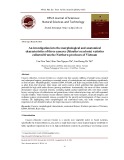
Vietnam Journal
of Agricultural
Sciences
ISSN 2588-1299
VJAS 2024; 7(1): 2040-2051
https://doi.org/10.31817/vjas.2024.7.1.03
https://vjas.vnua.edu.vn/
2040
Received: June 19, 2023
Accepted: March 22, 2024
Correspondence to
ltnha.cntp@vnua.edu.vn
ORCID
Lai Thi Ngoc Ha
https://orcid.org/0000-0003-1020-
3752
Exploitation of Catechin Extract from Pruned
Tea Leaves as a Promising Food
Preservative Against Lipid Oxidation
Lai Thi Ngoc Ha*, Tran Thi Hoai, Hoang Lan Phuong & Nguyen
Van Lam
Faculty of Food Science and Technology, Vietnam National University of Agriculture,
Hanoi 131000, Vietnam
Abstract
In Vietnam, a tea-producing country, the tea buds and top three leaves
are normally used for tea production while older leaves are pruned
and discarded as agricultural waste in the winter. The present study
aimed to exploit catechins from pruned tea leaves and use them as
natural antioxidants for applications in the food industry. Catechins
were analyzed using the guideline of ISO 14502-2-2005 by HPLC-
MWD. The contents of catechins in pruned tea leaves of ten popular
tea varieties were relatively high, ranging from 65.57 to 136.88 mg/g
dry weight. The optimized conditions for catechin extraction from
Phuc Van Tien pruned tea leaves (one of the varieties with a high
catechin content) were found using response surface methodology as
follows: a liquid-to-solid ratio of 21.6/1 at 70oC for 31 minutes. The
catechin-rich extract powder was added to sesame oil to inhibit lipid
oxidation. During oil accelerated oxidation at 60oC, the catechin-rich
extract powder inhibited the increase of the peroxide value compared
with the negative and positive controls (no preservative and added
tert-butylhydroquinone, respectively). Significant positive
correlations between the decrease of catechin content and the
inhibition of peroxide formation (r = 0.91, 0.94, 0.95, 0.97, and 0.96
for catechin, epigallocatechin gallate, epigallocatechin, epicatechin
gallate, and epicatechin, respectively, P <0.05) proved that the
inhibition of peroxide formation in the sesame oil was essentially due
to the antioxidant capacity of the catechins in the pruned tea leaf
extract. Catechin extracts from pruned tea leaves are potential sources
of natural antioxidants for oil preservation.
Keywords
Phenolic compounds, catechin extraction, response surface
methodology, lipid oxidation
Introduction
Tea (Camellia sinensis) is one of the most popularly consumed
beverages in the world (Prasanth et al., 2019). Tea leaves contain a

Lai Thi Ngoc Ha et al. (2024)
https://vjas.vnua.edu.vn/
2041
high quantity of catechins, which are considered
strong natural antioxidants (Gulua et al., 2019).
These compounds have been reported to prevent
lipid oxidation, a major problem in the food
industry (Toschi et al., 2000; Hara, 2001). Tea
leaf polyphenols have been shown to be effective
in preserving meat (Yang et al., 2017; Bellés et
al., 2018), oil (Hara, 2001; Nain et al., 2021),
seafood (Fıçıcılar et al., 2018), and even
biodiesel (Bharti & Singh, 2019). Tea
polyphenols have also been shown to have
significant effects on delaying the increase of
total volatile base nitrogen (TVB-N, the product
produced by protein decomposition), inhibiting
bacterial growth (Yang et al., 2017), reducing the
formation of peroxide and secondary oxidation
products in oil (Nain et al., 2021), and extending
the shelf-life of foods (Yang et al., 2017; Nain et
al., 2021).
The content of catechins is higher in young
leaves that are used for drinking tea than in older
ones. The young tea leaves are harvested in the
spring, summer, and autumn. In winter, the tea
plants are pruned to shape, which stimulates new
growth buds in the spring. This source of pruned
tea leaves (PTL) is discarded and used as mulch
for the soil (Figure 1). Nonetheless, this leaf
source has been analyzed and determined to have
potential natural anti-oxidative compounds
(Zandi & Gordon, 1999; Vuong et al., 2012).
Those were (+)-catechin (C), (-)-epicatechin
(EC), epicatechin gallate (ECG), (-)-
epigallocatechin (EGC), and (-)-epigallocatechin
gallate (EGCG). Interestingly, their antioxidant
activity could be higher than that of butylated
hydroxyanisole (BHA), an artificial antioxidant,
when added to lard, fish oil, and soybean oil
(Shahidi, 2015).
The objective of this study was to exploit the
catechins in PTL and apply them in inhibiting
lipid oxidation. To achieve this goal, firstly, the
catechin content in the PTL of ten popular tea
varieties in Vietnam was evaluated. Then, the
variety containing the highest catechin quantity
was used as the material for optimizing the
catechin extraction process. Finally, the ability to
inhibit lipid oxidation of catechin-rich extract
powder from PTL was evaluated.
Materials and Methods
Chemicals and reagents
Standards, namely (+)-catechin, (-)-
epicatechin, (-)-epigallocatechin, (-)- epicatechin
gallate, (-)-epigallocatechin gallate, and caffeine
at HPLC grade, were obtained from Sigma-
Aldrich (Germany). Absolute ethanol,
acetonitrile, and acetic acid were purchased from
Merck (Germany). Vitamin C was supplied by
Kanto Chemical (Japan).
Ethylenediaminetetraacetic acid (EDTA) was
bought from Norgen (Canada). Sodium
thiosulfate was obtained from Samchun (Korea).
Tert-butylhydroquinone (TBHQ) was obtained
from Eastman Chemical (Kingsport, Tennessee).
Virgin black sesame oil was obtained from the
Bao Tam Company (Vietnam).
Leaf collection and preparation
PTL were collected in 2016 and 2017 for
analyzing catechin content and for optimizing the
catechin extraction conditions, respectively. To
determine the catechin content, tea leaves from
the pruned part (20cm from the top of the tea
tree) of ten tea varieties were collected at the
Northern Mountainous Agriculture and Forestry
Figure 1. Old tea leaves before pruning (A) and the PTL (B, C)

Exploitation of catechin extract from pruned tea leaves as a promising food preservative against liquid oxidation
2042
Vietnam Journal of Agricultural Sciences
Science Institute (NOMAFSI), Phu Tho
province, Vietnam, in November 2016. The ages
of the tea trees ranged from 7-10 years and the
heights were 0.8-1m. Leaves were then placed
into paper bags and transported to the laboratory
of NOMAFSI on the same day. Five biological
replications (each of 200g) were taken.
At the laboratory of NOMAFSI, the
polyphenol oxidases of the tea leaves were
immediately deactivated by steaming for 4-5
minutes. After steaming, the tea leaves were
dried at 73-80oC in an oven until the moisture
content was reduced to about 5-8%.
For the catechin extraction optimization, PTL
of the Phuc Van Tien variety was collected in
November 2017 and treated as described above.
Determination of catechins in pruned tea
leaves
Catechins extraction
Catechin determination was conducted using
the guidelines of ISO 14502-2-2005. Briefly,
approximately 0.2g of ground dry tea leaves was
mixed with 5mL of methanol 70% in a 15-mL
centrifugation tube and shaken for 10 minutes at
70oC. After centrifugation at 3,830g for 10
minutes at 4oC, the supernatant was collected,
and the residue was extracted one more time with
the same volume of the same solvent. The
supernatants from the two successive extractions
were pooled in a volumetric flask of 10mL and
methanol 70% was added to the 10mL mark.
Extractions were done in triplicate. Each extract
was then filtered through a 0.45µm pore-size
syringe (Phenex™-NY, Utrecht, The
Netherlands), and diluted with a stabilizing
solution containing acetonitrile 10% (v/v),
ascorbic acid 500 µg mL-1, and EDTA 500 µg
mL-1 before HPLC analysis.
HPLC analysis of catechins
Quantification of the catechins was
performed by HPLC using an Aligent system
1260 (Santa Clara, CA) equipped with G1311B-
Quat pumps, G1329B autosampler, G1330B
thermostat, and G1365 MWD VL lamp. A 20-µL
aliquot of an extract was injected into a Kinetex
EVO C18 column (150x4.6mm i.d: 5µm particle
size) equipped with a guard column of the same
type (Phenomenex, Netherlands). The mobile
phases were A (20 µg mL-1 EDTA, 2% acetic
acid, 9% acetonitrile) and B (20 µg mL-1 EDTA,
2% acetic acid, 80% acetonitrile). The flow rate
was 1 mL min-1 and the column temperature was
30oC. The gradient elution was as follows: 0-
7.5min, 0% B; 7.5-15min, 0-30% B; 15-20min,
30% B; 20-25min, 30-100% B; 25-29min, 100%
B; 29-34min, 100-0% B; and 34-36min, 0% B.
Monitoring was set at 278nm. Catechins were
identified by their retention times as compared to
the authentic standards (Figure 2) and were
quantified using five-point calibration curves.
Optimization of catechin extraction from the
PTL of the Phuc Van Tien variety by food
grade solvent
The response surface methodology was used
for optimizing the extraction conditions of
catechins from PTL. A three-factor and rotatable
central composite design (CCD) consisting of 21
experimental runs with eight factorial points, six
axial points, and three replicates at the center point
and maximal and minimal factorial points (Table
1) were employed. The design variables were the
liquid-to-solid ratio (15/1-25/1, X1), extraction
temperature (45-85oC; X2), and the extraction
time (30-90 min; X3). The variables of ethanol
concentration (50%) and particle size (< 0.3mm)
were kept at constant values. Responses were the
total catechins and EGCG content of the PTL.
For all runs, extractions were done in 15-mL
falcon tube. Extractions were terminated by
centrifugation at 3,830g for 10 minutes at 4oC.
The obtained extracts were collected, filtered,
and analyzed by HPLC-MWD. The experimental
data were fitted to the following second-order
polynomial model:
Y = β0 +∑β
k
i=1 ixi +∑β
k
i=1 ijxi
2 +∑ ∑ β
k
j
k−1
iijxixj
where Y is the response, βo, βi, βii, and βij are
the regression coefficients for the intercept,
linear, quadratic and interactions terms,
respectively, and xi and xj are the coded values of
the independent variables. The formula used to
convert the coded values to real values and vice
versa was as follows xi = (Xi -X0)/Xi, where xi

Lai Thi Ngoc Ha et al. (2024)
https://vjas.vnua.edu.vn/
2043
Figure 2. HPLC chromatograms of the catechin standards (A) and the PTL of the Phuc Van Tien variety (B)
and Xi are the dimensionless and the real values
of the independent variable i (i = 1, 2 and 3),
respectively, X0 is the real value of the
independent variable i at the central point, and
Xi is the step change of Xi corresponding to a
unit variation of the dimensionless value.
The optimum conditions of catechin
extraction were determined by using JMP 10
software. The software was set to search for the
optimum desirability of the response variables
(maximum EGCG content and total catechins).
The validation of the model was carried out by
determining the content of the interest
compounds extracted at the optimal conditions
with four replicates. The experimental results
were compared with the predicted values.
Oxidative stability of sesame oil enriched with
catechins from pruned tea leaf extract
Preparation of tea leaf extract powder
PTL from the variety with high total
catechins were collected in large amounts to
produce the extract powder. The extraction was
performed in a dark glass bottle that contained 2
liters of ethanol 50% at the optimized conditions.
After shaking, the mixture was centrifuged at

Exploitation of catechin extract from pruned tea leaves as a promising food preservative against liquid oxidation
2044
Vietnam Journal of Agricultural Sciences
Table 1. Rotatable central composite design setting in the coded form (x1, x2, x3) and real values of the independent variables (X1,
X2 and X3) with the experimental results for the response variables (EGCG content and total catechins of Phuc Van Tien PTL)
Run
Standard variables
Real variables
EGCG
(mg/g DW)
Total
catechins (mg/g DW)
x1
x2
x3
X1 - Liquid/solid
ratio
X2 - Temperature
(°C)
X3 - Time
(min)
1A
1
1
1
25
85
90
43.15
103.92
1B
1
1
1
25
85
90
41.67
100.48
1C
1
1
1
25
85
90
45.84
109.93
2
-1
1
1
15
85
90
41.03
99.54
3
1
-1
1
25
45
90
51.25
124.47
4
-1
-1
1
15
45
90
47.41
116.92
5
1
1
-1
25
85
30
52.17
126.30
6
-1
1
-1
15
85
30
49.00
119.58
7
1
-1
-1
25
45
30
49.34
120.34
8A
-1
-1
-1
15
45
30
47.56
117.53
8B
-1
-1
-1
15
45
30
47.47
116.90
8C
-1
-1
-1
15
45
30
48.77
120.12
9
1.68
0
0
28.4
65
60
50.38
121.77
10
-
1.68
0
0
11.6
65
60
47.29
115.86
11
0
1.68
0
20
98.6
60
44.21
106.18
12
0
-
1.68
0
20
31.4
60
48.14
118.60
13
0
0
1.68
20
65
110.4
49.96
121.59
14
0
0
-
1.68
20
65
9.6
48.92
120.54
15A
0
0
0
20
65
60
49.47
120.96
15B
0
0
0
20
65
60
51.24
125.01
15C
0
0
0
20
65
60
53.61
131.08
3,830g for 10min at 4oC, and the supernatant was
then collected. The solvent in the extract was
evaporated in a rotavapor at 40oC. Finally, the
concentrated extract was freeze-dried to obtain
the PTL extract powder.
Preparation of the catechins enriched
sesame oil
Sesame oil was enriched with PTL extract
powder at two levels: 100mg and 200mg of
catechins per kilogram of oil. The tea extract
powder was dissolved in absolute ethanol and
added to the oil to reach the required catechin
concentration. The ethanol was evaporated from
the oil by degassing at 30oC for 15min. After that,
the oil was transferred to glass bottles without
lids (20 mL/bottle) and stored at 60oC in the dark
for 18 days. Samples with 100ppm of TBHQ
(positive control) and without preservatives
(negative control) were prepared in the same
way. Oil samples were taken and the peroxide
value was analyzed every 3 days.
Simultaneously, catechins in the oil were
extracted and analyzed by HPLC.
Extraction of catechins from sesame oil and
determination of peroxide value
The extraction of catechins from the sesame
oil was conducted using the methods described
by Salta et al. (2007) with minor modifications.
Catechin enriched oil (1.2g) was extracted three
times with methanol, 0.2mL for each extraction.
The mixture of oil and methanol was shaken
vigorously and then centrifuged at 3,508g for 1


